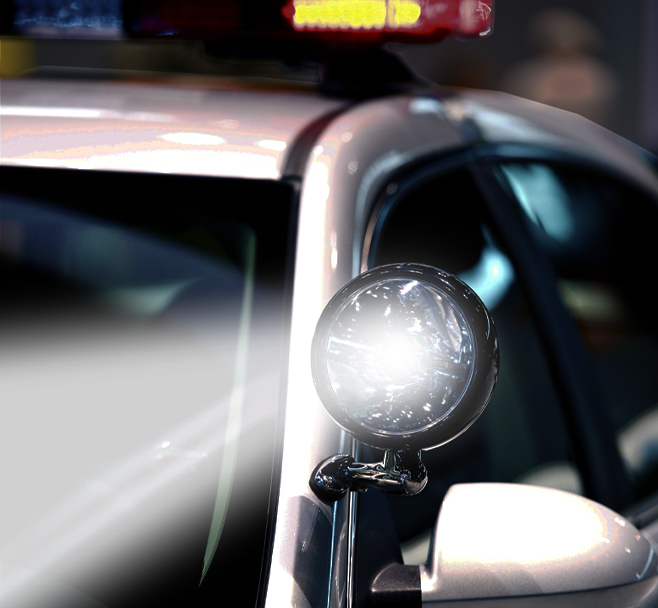People v. Leon Tacardon14 Cal. 5th 235 (2022) CA Supreme Court
Question: Are you being detained if an officer shines his vehicle spotlight on you, but doesn’t turn on the red and blue emergency lights?
Answer: Generally, no. The use of a spotlight will not, standing alone constitute a detention; but will be considered in the totality of the circumstances.
Facts: Around 2045 hours, Grubb was patrolling a residential neighborhood in an area known for narcotics sales and weapons possession. He drove past a BMW parked in front of a residence and saw it was occupied by three people. As he drove past, Grubb made eye contact with the driver, Tacardon. Grubb made a U-turn, parked about 15-20 feet behind the BMW, and turned his spotlight on. He did not activate the siren, his emergency lights, or issue any commands to the occupants. He stayed in his patrol car for approximately 15 seconds while he put out his location and the license plate to dispatch and then he approached the BMW at a walking pace without drawing his weapon. Grubb used his flashlight to check the passenger compartment of the car. In plain view, he saw two small, clear, plastic bags which contained what he believed to be marijuana. He asked Tacardon for his identification and if he was on probation/parole to which Tacardon admitted he was on probation. A search of the car yielded 24 oz. of marijuana, 76 hydrocodone pills, and $1,904 in cash. Tacardon was arrested and charged with possession for sale.Tacardon asked the court to suppress the evidence arguing that the use of Grubb’s spotlight constituted an illegal detention. The Superior Court agreed, granted Tacardon’s motion, and dismissed the charges.
Discussion: The issue here is whether Tacardon was detained, meaning restrained by means of physical force or show of authority.Courts have been split on whether the use of a spotlight is a large enough “show of authority” that would cause a reasonable person to believe they were not free to leave. The California Supreme Court resolved this issue. In situations involving a show of authority, a person is detained when, “in view of all the circumstances . . . a reasonable person would believe they are not free to leave or otherwiseterminate the encounter, and if the person actually submits to the show of authority.”
People v. Brown, 61 Cal.4th 968, 974 (2015).
In Brown, the court did not create a rule stating the use of emergency lights near a parked car will always constitute a detention and noted, because someone whose car had broken down on the highway might reasonably believe the officer is stopping to render aid or warn other motorists of the potential hazard. Instead, the use of emergency lights must be considered in the totality of the circumstance in each individual incident.
The Court noted some examples of circumstances that could establish a detention including:
•The presence of multiple officers,
•Displaying a weapon,
•Physically touching a person, •Using the patrol car to block movement,
•Commanding language and tone of voice,
•The use of the siren
Here are some examples when a spotlight did or did not constitute a detention. In People v. Franklin, 192 Cal.App.3d 935 (1987) the court found no detention when an officer pulled behind a person walking and shined a spotlight on him because the officer didn’t block the person’s way nor gave any verbal commands. Likewise, in U.S. v. Campbell-Martin,17 F.4th 807, 811-812 (8th Cir. 2021) the court found no detention where an officer parked two spots away from the defendant’s car, shined a spotlight on it, and approached on foot.
However, in U.S. v. Delany, 955 F.3d 1077, 1079-80, 1082-83 (D.C. Cir. 2020), the court found a detention when officers parked within a few feet of the front of the defendant’s car in a narrow parking lot effectively blocking him in, and activated the take-down lights.
In this case, the Court declined to establish a bright-line rule regarding the use of spotlights or take-down lights because their use should always be considered as a factor in the totality of circumstances.
The Court found the circumstances here were clear. Tacardon was not detained when Grubbparked behind the BMW, shined the spotlight on it, and began to approach on foot. The “conduct up to this point conveyed none of the coercive hallmarks of a detention. He did not stop Tacardon’s vehicle or block him from driving away. He did not activate a siren or emergency lights, or give directions by loudspeaker. He did not approach rapidly or aggressively on foot or draw a weapon. He gave no commands . . . until the woman got out of the car and began to walk away.”
The Court found, “a reasonable person would understand that spotlights can have a practical function . . . [and] can be used to illuminate the surrounding area for safety or other purposes unrelated to the projection of authority.”
Bottom Line:
The use of spotlights or takedowns lights will not, on their own, necessarily constitute a detention; but will be considered as part of the totality of the circumstances.
Stay Safe and Healthy!

